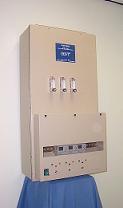NATIONAL REPORT—With water heating accounting for approximately 40 percent of a hotel’s energy consumption, it is no wonder that an increasing number of hotels are implementing ozone laundry systems. Provided by about a dozen vendors around the United States, these systems can save about 80 percent in hot water consumption and up to 30 percent in overall water usage.
The trend toward ozone system implementation comes at a time when an increasing number of hotels are bringing their laundry operations in-house. Jack Reiff, president of Worcester, Mass.-based Wet-Tech, says hotel operators who switch to ozone systems benefit from much more than just reduced energy and water costs. The amount of chemicals needed for washing can be reduced by 30 percent, linens smell fresh and without a chlorine odor.
“Added life to the linen that remains in service has proven to be 50 percent,” adds James Gross, president of Ozone Water Technologies, Tryon, N.C. “What wears linen out is chlorine.”
Various types of ozone laundry systems are available. Some hold ozone in a water tank outside of the washing machine until ready for use. The downside to this type of system is that the ozone can dissipate in just a minute or two if left to sit. Others like Wet-Tech’s EnviroSaver II and Ozone Water Technologies’ LaundrOzone system inject the ozone directly into the washers without having it sit for any period of time.
How Ozone Works
According to Ozone Water Technologies, ozone is 3,000 times faster than chlorine when it comes to sterilizing linens. Because ozone reverts back to pure oxygen after it is used, there are no chemical residues.
“Ozone is an oxidizer,” Wet-Tech’s Reiff says. “It brightens linens without the problems of chlorine. It actually neutralizes the chlorine.”
When using an ozone system, fewer cycles are needed to wash clothing. For effective body soil removal, hot water is no longer needed but warm water is. If only cold water is used, the body soil will coagulate.
“We only use oxygen bleach—not chlorine bleach,” Gross says. “Non-ionic detergent works best.”
It is imperative that hotel operators work with their chemical suppliers to purchase the appropriate chemicals for an ozone system. Because water and washers are different in every location, it may take a few tries to pinpoint the correct chemical quantity.
Ozone laundry systems are easy to maintain and can be attached to any commercial laundry machine. Because the ozone is produced in the system itself, there is never a need to purchase ozone. Only minor filter cleaning is required. Systems can run 24 hours a day and be located behind the washers—on the wall, for example.
Linens washed in ozone require less water to rinse and about 8 to 10 percent less time to dry in dryers. Because fewer cycles are needed to wash linens, staff can be more productive and even get out an extra load each day. That adds up to even more savings for a hotel.
Reiff says a hotel with 100 rooms or more can expect payback in a year or less, assuming 80 percent occupancy. Utility rates will impact payback time. Smaller hotels may not see a full return on investment for two to three years.
Before purchasing an ozone laundry system, Reiff says to be sure to check the vendor’s service record and history. Do not look at short-term dollars, he says; consider the long-term payback.
For the environment, the benefits are many. Less energy needs to be produced, fewer chemicals are required, and the water exiting the hotel to the sewage system is cleaner.
Also see NuTek International Inc. for ozone system information.
Glenn Hasek can be reached at greenlodgingnews@aol.com.








